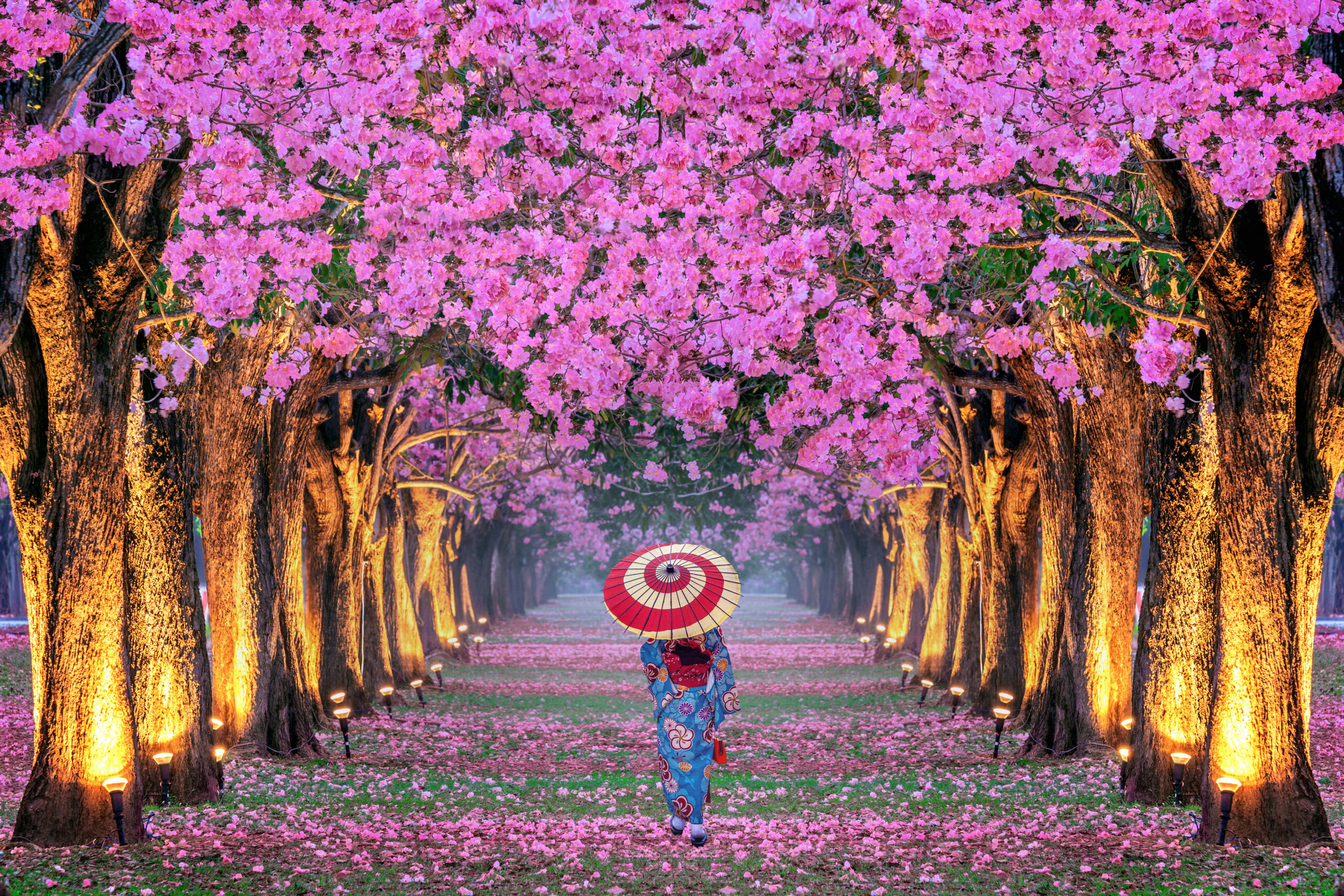Japan, the Land of the Rising Sun, is a captivating destination that seamlessly blends its rich cultural heritage with modern innovation. From the bustling metropolis of Tokyo to the serene temples of Kyoto and the natural wonders of Hokkaido, Japan offers a diverse range of experiences for travelers. While Japan may have a reputation for being an expensive destination, it is entirely possible to explore this beautiful country on a budget. In this article, We’ll provide you with invaluable tips and insights to make your dream trip to Japan affordable and unforgettable.
What is Japan known for among tourists?
 Japan is known for a multitude of attractions that draw tourists from all over the world. Here are some of the highlights:
Japan is known for a multitude of attractions that draw tourists from all over the world. Here are some of the highlights:
- Cherry Blossom Festivals: Japan’s cherry blossoms, or sakura, are world-famous. Springtime, usually in April, sees the entire country adorned in shades of pink and white, making it a prime season for tourists.
- Traditional Culture: Japan is renowned for its rich cultural heritage, which includes tea ceremonies, kabuki theater, sumo wrestling, and the art of ikebana (flower arranging).
- Cuisine: Japanese cuisine is celebrated globally. From sushi and sashimi to ramen and tempura, there is a wide variety of delicious dishes to try.
- Temples and Shrines: Japan boasts thousands of temples and shrines, each with its unique charm and history. Kyoto, in particular, is home to many iconic ones.
- Technology and Innovation: Japan is at the forefront of technological advancements. Visiting Tokyo is like taking a glimpse into the future with its cutting-edge gadgets and futuristic architecture.
- Nature and Hot Springs: Japan’s natural beauty is breathtaking. Explore lush forests, hike up scenic mountains, and relax in traditional onsen (hot springs).
Why is Japan a popular tourist attraction?
 Japan’s popularity as a tourist destination can be attributed to several factors:
Japan’s popularity as a tourist destination can be attributed to several factors:
- Cultural Richness: Japan’s unique blend of ancient traditions and modernity is a significant draw. Travelers can experience both the serenity of ancient temples and the hustle and bustle of ultra-modern cities.
- Safety: Japan is known for its low crime rates, making it a safe destination for tourists. This sense of security allows visitors to explore with peace of mind.
- Scenic Beauty: Japan’s diverse landscapes, from cherry blossom-lined streets to snow-capped mountains and pristine beaches, offer stunning visuals and natural beauty throughout the year.
- Cuisine: Japanese food is loved worldwide, and experiencing it in its place of origin is a dream come true for many. The freshness and authenticity of Japanese cuisine are unmatched.
- Efficient Transportation: Japan’s world-class public transportation system makes it easy for travelers to navigate the country. Trains, buses, and subways are punctual and well-connected.
- Politeness and Hospitality: Japanese people are known for their politeness and hospitality, making visitors feel welcome and respected.
What month is cheapest to visit Japan?
 If you’re looking to visit Japan on a budget, consider traveling during the shoulder seasons, which are the spring and autumn months. April and May, as well as September and October, are typically the cheapest times to visit. During these periods, you can avoid the peak tourist season while still enjoying pleasant weather and beautiful scenery.
If you’re looking to visit Japan on a budget, consider traveling during the shoulder seasons, which are the spring and autumn months. April and May, as well as September and October, are typically the cheapest times to visit. During these periods, you can avoid the peak tourist season while still enjoying pleasant weather and beautiful scenery.
What are the best and worst months to visit Japan?
The best months to visit Japan depend on your preferences and what you want to experience. Here’s a breakdown:
-
Best Months:
- Spring (March to May): Cherry blossoms bloom in April, and the weather is generally mild and pleasant.
- Autumn (September to November): Enjoy colorful foliage, comfortable temperatures, and fewer crowds.
-
Worst Months:
- Summer (June to August): Japan’s summer can be hot and humid, with occasional typhoons. This season can be less comfortable for outdoor activities.
- Winter (December to February): While winter has its charm, it can be quite cold, especially in northern regions.
How far in advance should I plan for Japan?

Planning your trip to Japan well in advance is crucial, especially if you’re on a budget. Aim to start planning at least 6 to 9 months before your intended travel dates. This allows you to secure affordable airfare, accommodations, and any special activities or tours you want to book.
What time of year is most expensive to visit Japan?
 The most expensive time to visit Japan is during the cherry blossom season, which typically occurs in April. During this period, both domestic and international tourists flock to Japan to witness the breathtaking cherry blossoms, driving up prices for accommodations and flights. If you’re on a budget, consider traveling just before or after this peak season to save money.
The most expensive time to visit Japan is during the cherry blossom season, which typically occurs in April. During this period, both domestic and international tourists flock to Japan to witness the breathtaking cherry blossoms, driving up prices for accommodations and flights. If you’re on a budget, consider traveling just before or after this peak season to save money.
How much money do I need for 7 days in Japan?
 The amount of money you’ll need for a week in Japan can vary greatly depending on your travel style and preferences. However, here’s a rough estimate for a budget traveler:
The amount of money you’ll need for a week in Japan can vary greatly depending on your travel style and preferences. However, here’s a rough estimate for a budget traveler:
- Accommodation: $40 – $100 per night (hostels or budget hotels)
- Food: $20 – $50 per day (eating at local restaurants and street vendors)
- Transportation: $30 – $50 for a Japan Rail Pass (if you plan to travel between cities)
- Activities and Sightseeing: $20 – $50 per day
- Miscellaneous (souvenirs, toiletries, etc.): $10 – $20 per day
In total, you can expect to spend around $1,000 – $1,500 for a week in Japan as a budget traveler.
How many days in Japan is enough?
 The ideal duration for your trip to Japan depends on your interests and how much of the country you want to explore. However, here are some rough guidelines:
The ideal duration for your trip to Japan depends on your interests and how much of the country you want to explore. However, here are some rough guidelines:
- Short Trip (1-2 Weeks): If you have limited time, focus on one or two major regions, like Tokyo and Kyoto. You can still experience Japan’s highlights in this time frame.
- Medium Trip (2-3 Weeks): With a couple of weeks, you can explore multiple regions, such as Tokyo, Kyoto, Osaka, and Hiroshima, while also having time for day trips and more in-depth experiences.
- Extended Trip (3+ Weeks): For a more comprehensive experience, including less touristy areas like Hokkaido or Okinawa, consider a longer stay.
Ultimately, the more time you have, the better you can immerse yourself in Japan’s culture and explore its hidden gems.
Do you need a visa to go to Japan?
 Whether you need a visa to enter Japan depends on your nationality and the purpose of your visit. Citizens of many countries can enter Japan for short stays (usually up to 90 days) for tourism without a visa. However, it’s essential to check the specific visa requirements for your country on the official website of the Japanese embassy or consulate in your home country.
Whether you need a visa to enter Japan depends on your nationality and the purpose of your visit. Citizens of many countries can enter Japan for short stays (usually up to 90 days) for tourism without a visa. However, it’s essential to check the specific visa requirements for your country on the official website of the Japanese embassy or consulate in your home country.
What month is cherry blossom in Japan?
 Cherry blossoms in Japan typically bloom in April, although the exact timing can vary from year to year and by region. To catch the cherry blossoms at their peak, it’s a good idea to plan your visit for late March to early April in central Japan, such as Tokyo and Kyoto. In northern regions like Hokkaido, the cherry blossoms bloom a bit later, usually in May.
Cherry blossoms in Japan typically bloom in April, although the exact timing can vary from year to year and by region. To catch the cherry blossoms at their peak, it’s a good idea to plan your visit for late March to early April in central Japan, such as Tokyo and Kyoto. In northern regions like Hokkaido, the cherry blossoms bloom a bit later, usually in May.
Can I use my credit card in Japan?

Yes, you can use your credit card in Japan, especially in major cities and tourist areas. Most international credit cards like Visa, Mastercard, and American Express are widely accepted. However, it’s a good idea to carry some cash with you as there are still places, especially in rural areas or small establishments, that may not accept cards. Additionally, notify your bank about your travel plans to avoid any issues with card usage abroad.
Should I exchange money before I travel to Japan?
While it’s a good idea to have some Japanese yen on hand when you arrive in Japan for immediate expenses like transportation and meals, you don’t need to exchange all your money before your trip. You can exchange currency at the airport, banks, and currency exchange offices in Japan. It’s also common to withdraw yen from ATMs in Japan using your international debit or credit card.
Does Japan accept US dollars?
Japan primarily uses the Japanese yen (JPY) as its official currency. While some tourist-oriented businesses and hotels in major cities may accept US dollars, it’s not a widespread practice. It’s best to have Japanese yen for most transactions, as relying on US dollars may lead to unfavorable exchange rates and inconvenience.
Conclusion
Japan is a captivating destination that offers a wealth of experiences for travelers, from its rich cultural heritage to its modern innovations and natural beauty. By following these budget-friendly travel tips and guidelines, you can make your dream trip to Japan not only affordable but also incredibly rewarding. Whether you’re strolling under cherry blossoms in spring or exploring historic temples in autumn, Japan will undoubtedly leave you with cherished memories that will last a lifetime. So, start planning your budget-friendly adventure to the Land of the Rising Sun today!




